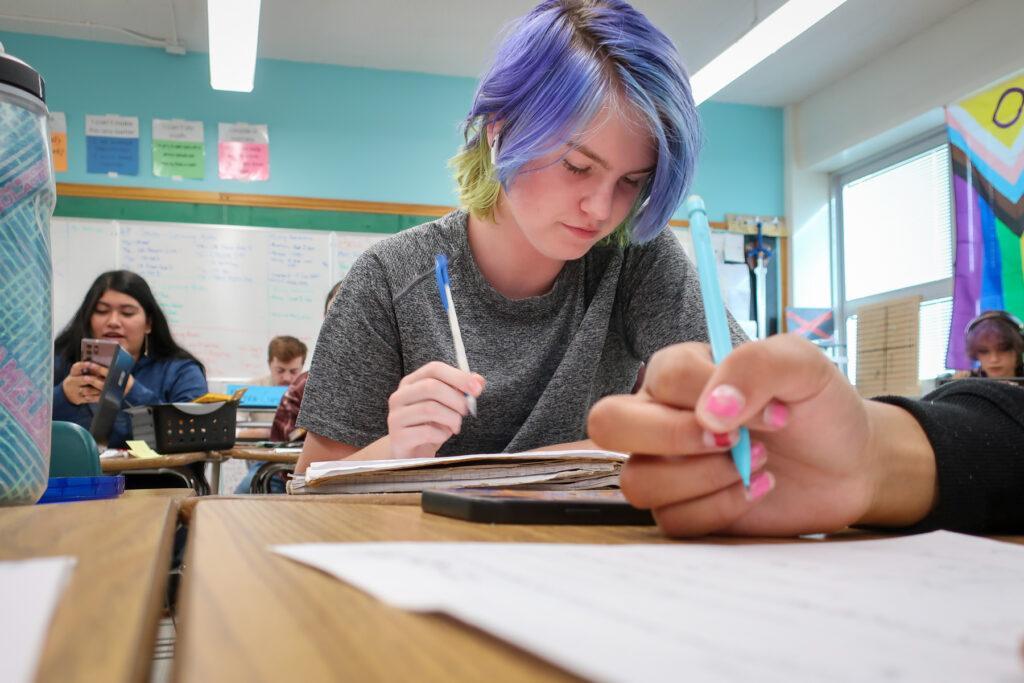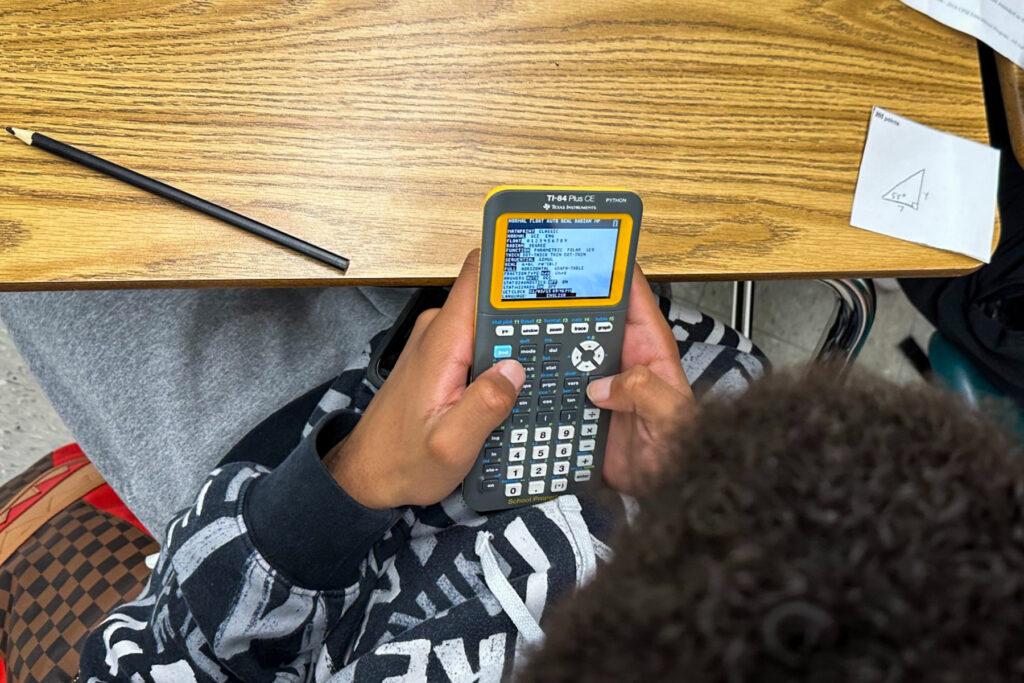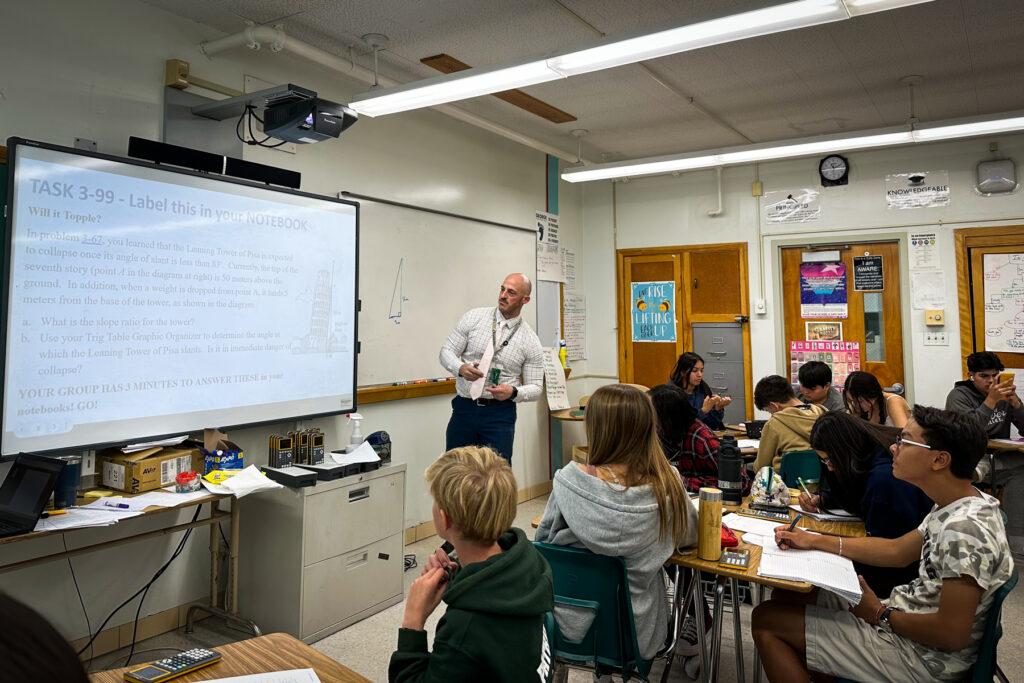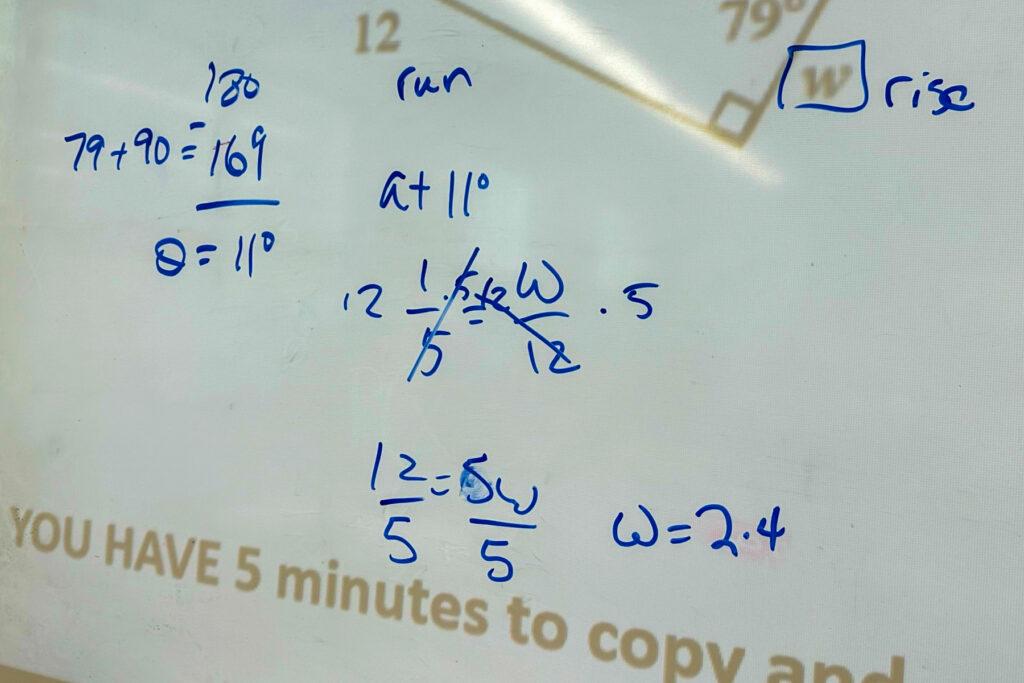
Tewodrose Nega is trying to find the length of a triangle’s side.
“So, I’m guessing we put x over 22 and then we put one-fifth over the other side,” he said, hovering over a piece of paper, madly scribbling with a pencil. “That’s how you solve it I think.”
He’s going at the problem with gusto — but is guessing just a little bit. George Washington High School math teacher Joe Bolz checks his work.
“I think you misread it … that’s not supposed to be 22, that’s supposed to be a 2 over there. It’s not the angle, it’s the side.”
Other students in this Integrated Math 2 class are running into the same problems — lots of pretty simple mistakes.
“We did 40 over x instead of x over 40 because this is the rise and this is the run apparently,” said one girl.
Slope is how steep a line is and mathematically that’s calculated as “rise over run,” the ratio of the vertical and horizontal changes between two points. It’s typically a concept introduced in seventh grade.
“For some people, slopes were their weakest spot, something they didn’t master before,” Bolz said, referring to the skills assessment students took at the outset of the year.
The pandemic had a massive impact on students — especially in math. The nation’s report card showed the largest decline in students’ math skills ever recorded. Colorado eighth graders’ tumble on those national tests was 10 points. Freshmen taking PSATs suffered a nearly nine-point drop in math last year. Fewer than a third of Colorado’s eighth graders are on grade level in math.
Bolz knows the sophomores and freshmen in this class missed a lot during the pandemic years. Those crucial middle school years pave the way for higher-level math. Advocates across the nation worry that the large plummet in math skills could lead to fewer students entering the STEM fields or trades that require math.
“What skills kids learn in sixth, seventh, and eighth grade are really foundational and heavy,” said Mary Pittman, president of the Colorado Council of Teachers of Mathematics and math project director at TNTP. “Those grade levels are a big deal and they're also probably the mathematics that most adults recognize.”
But experienced math teachers like Bolz have strategies they hope will catch students up.

Why were declines in math so steep? Well, have you ever tried learning math online when you were 13?
“You didn't really pay attention,” said freshman Ray Bolanowski, of virtual math during the pandemic years. “You kind of just did like the bare minimum so you wouldn't get in trouble and then you'd just, like, go back to sleep.”
He said in English or social studies, students read or wrote something during the virtual class so it was easier to engage. In math, teachers spent a lot of class trying to explain concepts that were hard to absorb, he said.
Teachers often couldn’t see what kids were doing or how they were confused. Freshman Keira Johnson said it was hard to interrupt and ask teachers questions.
“You’d have to see if they would pause and then you would unmute but sometimes it’s just like, screw it, I can’t,” she laughed.
Bolanowski said he’s really catching on in Bolz’s class, his first high school math class, but, “they’re some things when we go back to what we did in sixth and seventh grade, I feel completely lost.”
Students faced other challenges during the pandemic — some had family members who got sick and died, parents lost jobs, and kids like Samuel Meraz moved around a lot.
“I ended up going to one school in sixth grade, a different one in seventh grade, and a different one in eighth grade, so I probably missed a bit,” he said.
Others have other challenges.
“My first language is Spanish and I’m learning English so this is double the challenge,” Fabiana Rodriguez said in Spanish as she worked on slope ratios in a group.

What’s needed now to help kids catch up? The 'just-in-time' teaching strategy.
Instead of trying to review two years of what kids may have lost, Bolz advocates using “just-in-time” teaching strategies. Those are also known as accelerated learning, which calls for accelerating, not remediating.
“We know that they’re skills that the students are coming in that they're missing, but it's better if we can tie those skills to when they're going to be most applicable, when they're going to need them.”
Slope ratios will lead into something bigger that’s up next — trigonometry. And during quadratic functions, the class will review graphing. In other words, reviewing middle school concepts when they have relevance to something in high school math.
“Just-in-time,” or accelerated learning, anchors everything on grade level and fills in missed concepts as needed. One big study found that students spend most of their time in school without access to grade-appropriate assignments. While students met the requirements of class assignments 71 percent of the time, that work met grade-level standards only 17 percent of the time.
“We actually will teach kids less if we don't teach the grade level content,” said TNTP’s Pittman. “Students who were given access to grade-level work learned more and caught up and actually were pretty successful with it overall.”
Take a simple example. Third grade is all multiplication and division. In accelerated learning, teachers would start the year helping kids understand groups, the number of things in a group and totals, and connecting those ideas.
She recalls talking to math teachers about this concept when she was the math specialist with the Colorado Department of Education.
“When I started talking to them like, ‘no, I want you to start with multiplication and division,’ they would say, but not every kid's mastered adding and subtracting. And I would say, ‘yep, but you're going to work on adding and subtracting as you are working on multiplication and division.’ ”
She said the strategy is difficult, takes a deep understanding of math, and takes high-quality learning materials, which not all Colorado districts have.

Bolz designs his class for maximum interaction — sophomores especially need practice socializing post-pandemic.
Bolz’s math class is fast-paced, chock full of competition, games, and working in small groups – all hammering home the ‘slope’ concept. Group work is particularly important, especially for sophomores. Bolz said that age group was hardest hit by the pandemic because practically their entire middle school was online.
“Really just getting them to learn to talk to each other and to engage with each other and work with each other….that's been a bigger struggle this year than has been in the past for me,” he said.
For one math problem, Bolz appoints the oldest person in each group to lead a discussion about a problem. For the next problem, he tells them to change leaders, going clockwise.
“Clockwise is so confusing,” murmurs one student, a member of a generation raised on digital clocks.
Bolz has noticed something else since the pandemic.
“There's a lack of math confidence, a lack of self-efficacy,” he said.
He checks in with a student working on a problem, asking if they can perform 75 x 2 in their head. They can’t. Some struggle with basic computation like 9 times 7. Bolz said when that happens, the students think that means they’re bad at math. Bolz tells them to use the calculator for whatever they can.
“I don't want to let the multiplication of 7 and 9 get in the way of you understanding this problem, because that's not the crux of the problem.”
He makes sure students understand why they’re doing something and frequently checks for understanding, asking the class, “Where are we at with the Theta (θ)? Great? Awful? Somewhere in the middle?”
Most of the class gives a thumbs up.
So, what do Colorado educators need to improve students’ math skills right now?
More after-school tutors? Bolz said at the high school level, not exactly.
“There has to be buy-in first, right? We can offer whatever we want, but if students aren't going to stick around for it, it's not going to support us. But if we had more bodies in the classroom, it would definitely help.”
| Other ideas from teachers for improving math skills |
|---|
| - More school district leaders and teachers committing to “just-in-time” or accelerated learning/grade-level work. - Recruiting math teachers earlier in the hiring cycle, along with diversifying math teachers. - More state grants for districts to purchase high-quality math instruction materials and high-quality training for teachers. - Materials and tools that help teachers connect math to real-world problems and allow students to do hands-on math through project-based learning. - Other ideas from math teachers on how they’d like a $1.1 billion investment in math to be spent include trained intervention specialists with a background in math and special education; ongoing (not one-time) professional development support; grading and attendance software that works for teachers so they can have more time to focus on instruction; and reducing class sizes. |
He said the biggest help can come from parents. Taking an interest in what their kids are learning, asking about it, talking about it. That’s the first step to getting teenagers to come in for tutoring.
Pittman said having tutors work with students on a concept that they’ll learn before the next math class is a powerful practice.
“Let me preview this with you, let me get you a leg up for tomorrow. So now when I go into class as a student, rather than feeling lost and losing that hour now I'm actually going to actually learn something because I'm ready for it. I'm primed for it.”
One thing is for sure: Bolz said he’s a much better teacher post-pandemic.
He’s much more tuned into his students emotionally. Some students in this class are still having a rough time at home. Some have to care for siblings. One can’t keep his eyes open. Bolz is gentle with him. In the past, he’d be “breathing down his neck.”
Bolz thinks it was his own two years sitting in a dark basement teaching to a bunch of squares on a screen with no faces.
“I never saw the sun. It took a toll on me … It was very depressing. And I have 40-something years on me that I can try and kind of figure this out. I can't imagine how somebody that's 12 years old, 13 years old, who had to stay at home by themselves [did it].”
Though experts say it may take years and a lot of money to catch students up, as he gets ready for his next class, Bolz is positive about math and his students.
“I think we’ll be OK. I’m optimistic at least. This is one thing we’re going to get through.”










